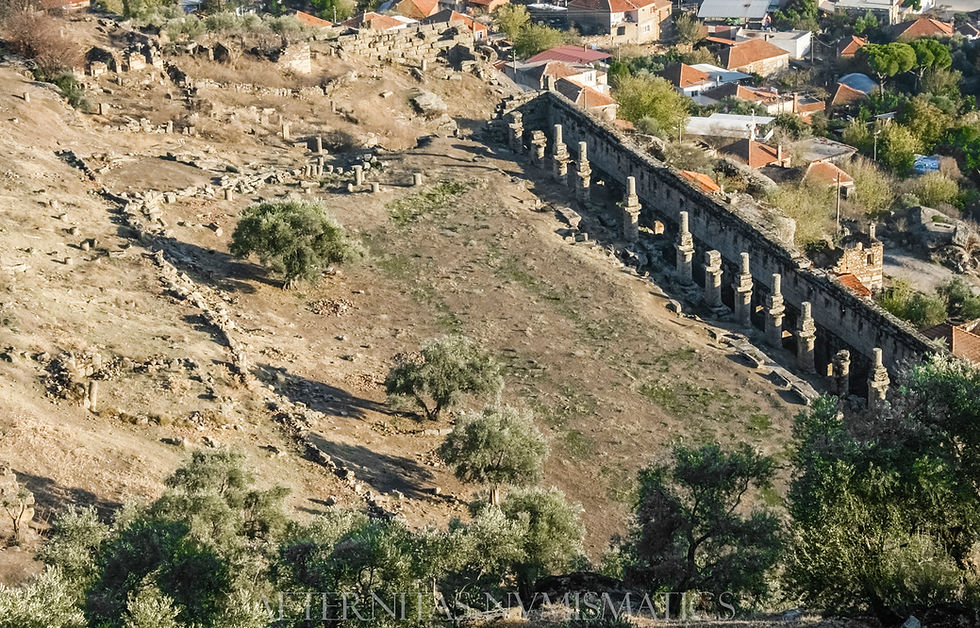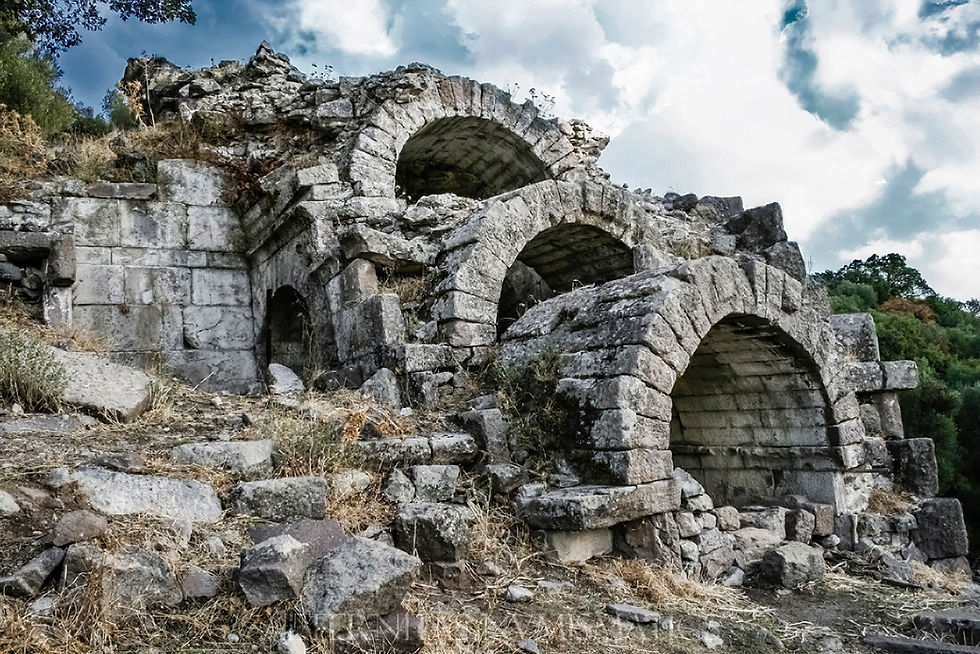Alinda: the powerful carian stronghold.
- Aeternitas Numismatics
- Oct 6, 2018
- 7 min read
The current Turkish town of Karpuzlu is the heiress of an ancient Carian city called Alinda. Its ruins are located on the top of the hill that rises to the west of the town. In fact, modern houses reach almost to the first ancient structures. Although Alinda has never been excavated except for its necropolis, the truth is that the archaeological site are fairly well preserved, deserving the qualification of monumental in some points.

Photo 1.- Exterior façade of the magnificent Alinda market. 2nd Century BC.
We commented in the previous paragraph that Alinda has never been excavated. If we add to that the short number of localized epigraphs, almost total absence of sculpted elements such as fragments of capitals, friezes or statues and a poor mention in the ancient chronicles, we have the perfect conditions for the history of the place to remain submerged in a certain darkness. We ignore, in fact, everything related to the origin of the city although an identification has been proposed between the Hittite city of Iyalanda (14th century BC), epigraphically known, and our Alinda based on the phonetic similarity between both names.


Photos 2 and 3.- Interior room of two of the market stores, where the exhibitor and the shop desk were located.
For a few years, not many, of the fifth century BC Alinda was a member of the Delos league: headed by Athens and with defensive purpose against the expansionist yearnings of the Persian Achaemenid empire. This indicates that at that time the city had a certain economic importance since otherwise it would not have been able to satisfy the tribute demanded to all the league members.


Photos 4 and 5. Two views of the gallery of double semicolumns that articulated the interior of the Alinda market second story.
Dissolved the league of Delos at the end of the fifth century BC, Alinda passes into Persian rule along with the rest of the great region of Caria. A little later, sometime in the first half of the fourth century BC, it enters into the orbit of influence of the Hecatomnid dynasty, based in Halicarnassus, the city from which the whole Caria was ruled with the acquiescence of the great Achaemenid power. It is thought that the walls of Alinda were erected by order of mythic King Mausolus (377-353 BC), the most important of the Hecatomnid monarchs.

Photo 6.- View of the Alinda agora with the ruins of the market to the right.
Upon the death of Mausolus, the throne passed to his wife (and sister) Artemisia, who would hold it for two years until her death in 351 BC. Hidrieus, brother of Artemisia and Mausolus, was elected new satrap (king-ruler of the Persian Empire) of Caria, a position he would hold for seven years, maintaining a formal allegiance to the Achaemenid monarch. Upon his death in 344 BC, his wife, Ada, who was also his sister, occupies the throne. This decision was not liked by Pixodarus, the younger brother of the family, who rose in revolt against his sister, the queen, expelling her from the capital, Halicarnassus (340 BC). However Ada proved not to be defeated at all. Thanks to the Greek historian Arrian we know that she managed to become strong in the "fortress of Alinda", governing from there a good part of Caria. It seems that the choice of Alinda as the main stronghold of the deposed queen was due to its great defensive capacity granted to by its powerful city-wall and by its location in height, surrounded by fairly vertical slopes and therefore difficult to access. In fact Arrian qualifies Alinda as "a place among the strongest of Caria".


Photos 7 and 8.- Ruins of a large building, of Hellenistic design, located in the vicinity of the Alinda agora.
Ada's control of Alinda greatly benefited the landing and subsequent Macedonian advance through lands of Asia Minor. Indeed, Persian forces trying to oppose Alexander the Great's army were deprived of the important Carian contingents due to Pixodarus needed to all his men to keep Queen Ada under control and prevent her from taking the throne. Considering that Caria's satrapy was, after that of Lydia, the most important of the whole micro-Asian West, it is plausible to suppose that the absence of the Carian reinforcements should significantly reduce the chances of Persian victory in the Granicus River battle, which concluded, as is known, with a total Macedonian triumph.


Photos 9 and 10.- Remains of buildings, possibly houses, scattered to the north of the Alinda agora.
Pixodarus dies in 344 BC, in a geopolitical situation marked by the collapse of Persian rule in Ionia (loss of Miletus) and Lydia (loss of Sardis) and the imminent penetration of the Macedonian enemy in Caria. Achaemenid monarch Darius III chooses as new Carian satrap a nobleman of his court called Orontobates, who had some right to the position due to he was married to a daughter of the late Pixodarus. Meanwhile, Alexander the Great has entered into Caria from the north. The news of the arrival of the Macedonian army is seen by Ada as an opportunity to reclaim her kingdom. In effect, during a meeting with the famous monarch, she proposes to hand over Alinda's fortress to him as well as to support him in the conquest of Caria if in return he restores her on his throne once Orontobates is defeated. Alexander accepts. The advantages of the deal are obvious: instead of having to reduce two resistance nuclei (that of Alinda and that of Halicarnassus, Ada and Orontobates), thus losing a precious time that the Persian enemy could take advantage of to organize, now he only should reduce one and besides had an ally who, properly reinforced with some Macedonian troops, could undertake that task while he continued eastward with the main army in demand of the heart of the Achaemenid empire. The pact was sealed with the recognition of Alexander as "son" of Queen Ada. The Macedonian, whose generosity to his allies is well known, did not even want to occupy Alinda. A year later, while Alexander was advancing through the eastern lands, Halicarnassus fell into the hands of Queen Ada after a hard siege. Confirmed as monarch of Caria by the Macedonian leader, she would hold the position until its death in the year 326 BC.


Photos 11 and 12.- Fragments of the Alinda city-wall, erected in the time of King Mausolus.
Brief and concise are the mentions about Alinda collected in the classic sources after the episode of Queen Ada. It seems that the city was renamed, shortly after these events, Alexandria ad Latmos (the mount on which it is located was called Latmos in antiquity) in recognition of the figure of the great Macedonian conqueror. By this time the city was still a carian city, not too hellenized. Over time its carian traits were fading away, becoming a full hellenized city.

Photo 13.- View (seen from outside) of the very well-preserved vaulted gallery (parados) that gave access to the interior of the Alinda theater. 2nd century BC.
During the 3rd century BC Alinda grows considerably. Its membership in the Chrysaorian League indicates that we are speaking about a city of some importance. In the middle of the 3rd century BC Alinda is under seleucid domain. It is a stronghold of considerable strategic value, whose defense is entrusted to a contingent of regular seleucid troops. The first monetary issuances coined in Alinda date from this historical moment, although its attribution to this city is doubtful, being valued also the possibility that they were minted in nearby Mylasa (now Milas). It is an issue of typical seleucid drachms, with bust of the monarch Antiochus II Teos on obverse and Apollo sitting over omphalus, holding an bow, on reverse. Its reduced volume of minting points to the fact that it was a government-type issuance destined to the payment of the garrisons; therefore it should not be supposed a especially outstanding economic dynamism in the region. In figure 1 we can see a beautiful examplar of this type auctioned by CNG on January 6th, 2015.

Figure 1.- Drachm coined in Alinda or Mylasa on behalf the seleucid monarch Antiochus II Teos (261-246 BC).
The 2nd century BC is also a period of moderate splendor for an Alinda that has already regained its original name. Although it does not mint silver coin, it does coin bronze, a sign that commerce is developing in the city and its area of influence. At the end of the century Alinda can be proud of having erected monumental buildings such as a temple of Apollo (where a statue of Aphrodite carved by the famous sculptor Praxiteles was guarded), a theater and a large market. It is clear that it was a reasonably prosperous city, without excesses.

Figure 2.- AE19 coined in Alinda between 145 and 130 BC. Juvenile male head to right (suspiciously similar to the seleucid king Demetrius II) on obverse, lightning and laurea on reverse.
Nothing is known about the long Roman stage of Alinda beyond certain evidence of reparatation in some buildings and a handful of monetary types, the great majority coined during the reign of Septimius Severus. They are almost always large specimens, more commemorative than functional in appearance. Considering that the nearby Alabanda also coined most of its provincial emissions during the severian period, it is possible to hypothesize some kind of benefit granted by Septimius Severus to the cities of northern Caria, which was celebrated minting several series of great size coins expressly dedicated to the imperial family. In figure 3 we can contemplate two large bronzes of this type. The one on the left is a huge AE39, dated in the period 208-211, on whose obverse Septimius Severus and Caracalla appear, in military dress, looking at each other; On the reverse, also very significant, appear Hercules and Septimius Severus, standing, shaking hands, with a lighted altar between them. The coin on the right is an AE36 coined in the biennium 202-203 in commemoration of the wedding between Caracalla and Plautilla, whose busts are shown on the obverse looking at each other. A beautiful representation of Apollo, with plectrum and lyre, occupies the reverse of this interesting monetary type.

Figure 3.- Large bronze coins minted in Alinda during the reign of Septimius Severus.
The Byzantine period of Alinda also remains plunged into darkness. It is known that the city did not disappear and that it still had to preserve a certain entity since it was chosen episcopal seat, suffragan of the metropolitan of Stauropolis (Aphrodisias). In fact the names of three of their bishops are known: Promachius (year 451), John (451) and Theodoret (536). It is possible that Alinda never completely depopulated, having survived to this day in the current Karpuzlu although translated to the lower slopes of Mount Latmos and the immediate plain.


Photos 14 and 15.- Two wiews of the ancient cavea (grandstands) of the theater.






















Comments